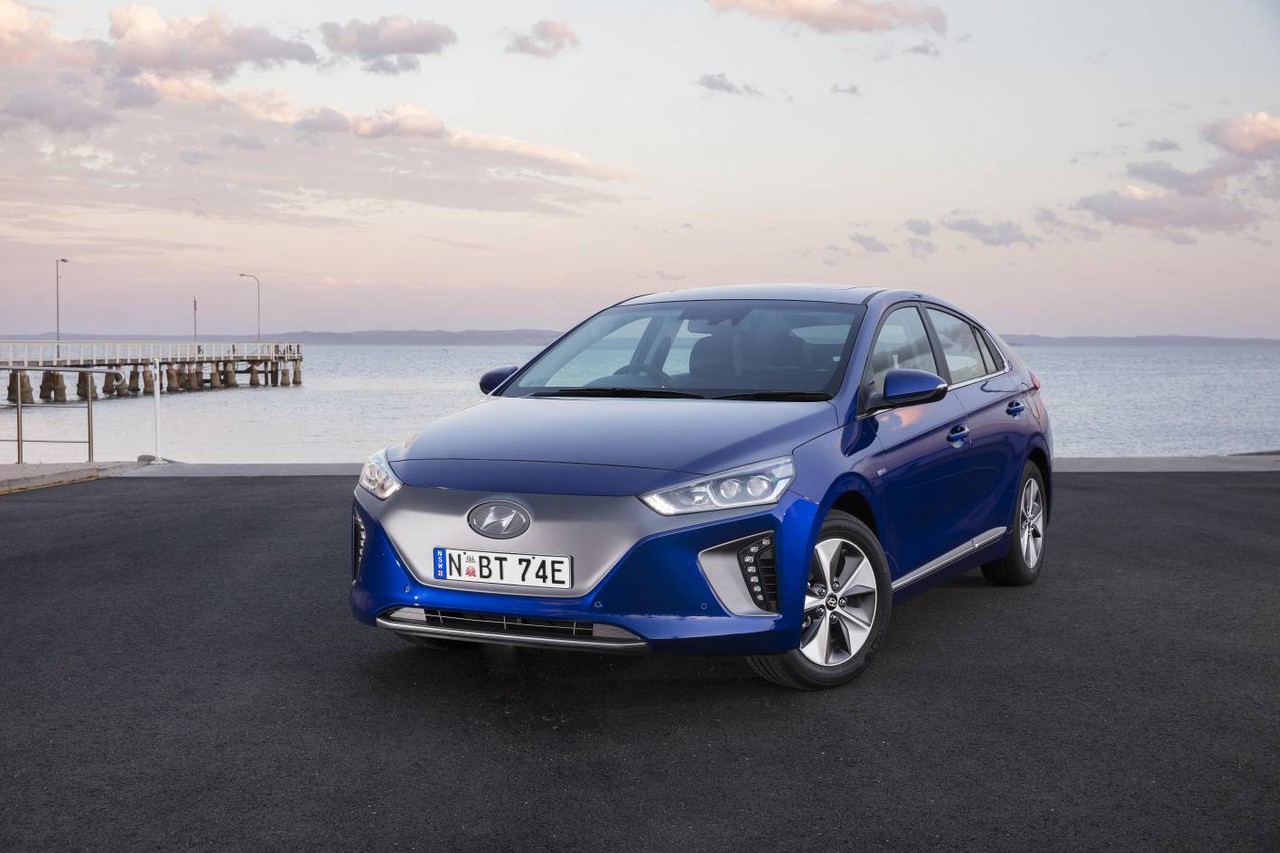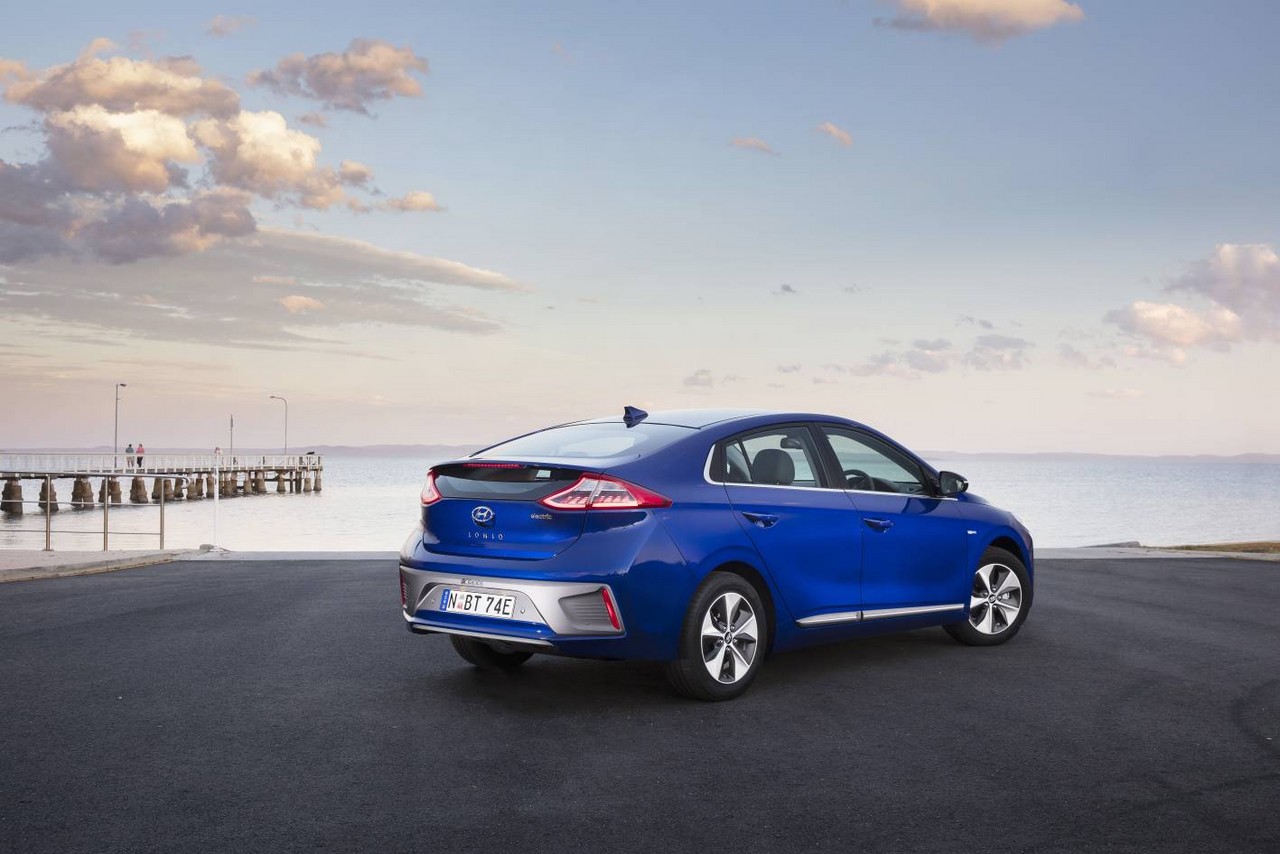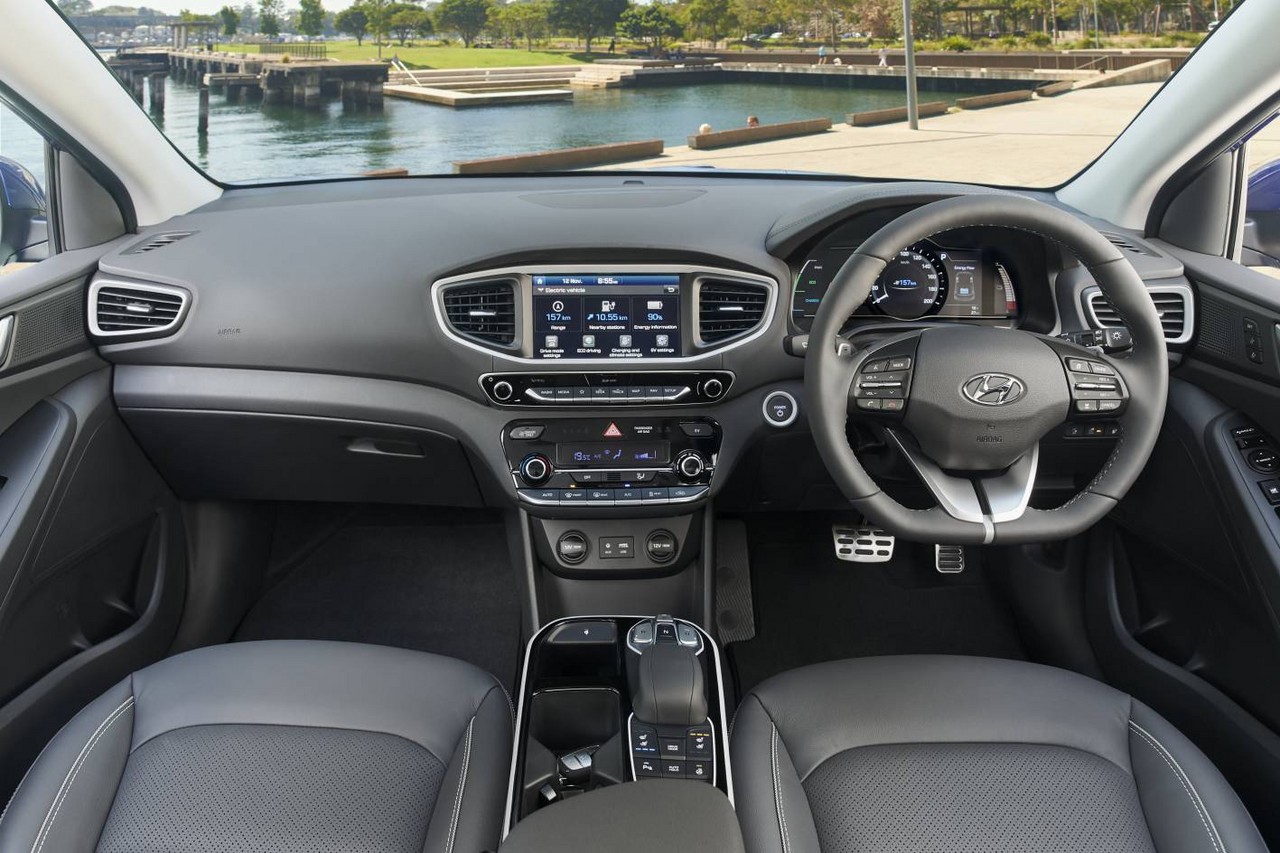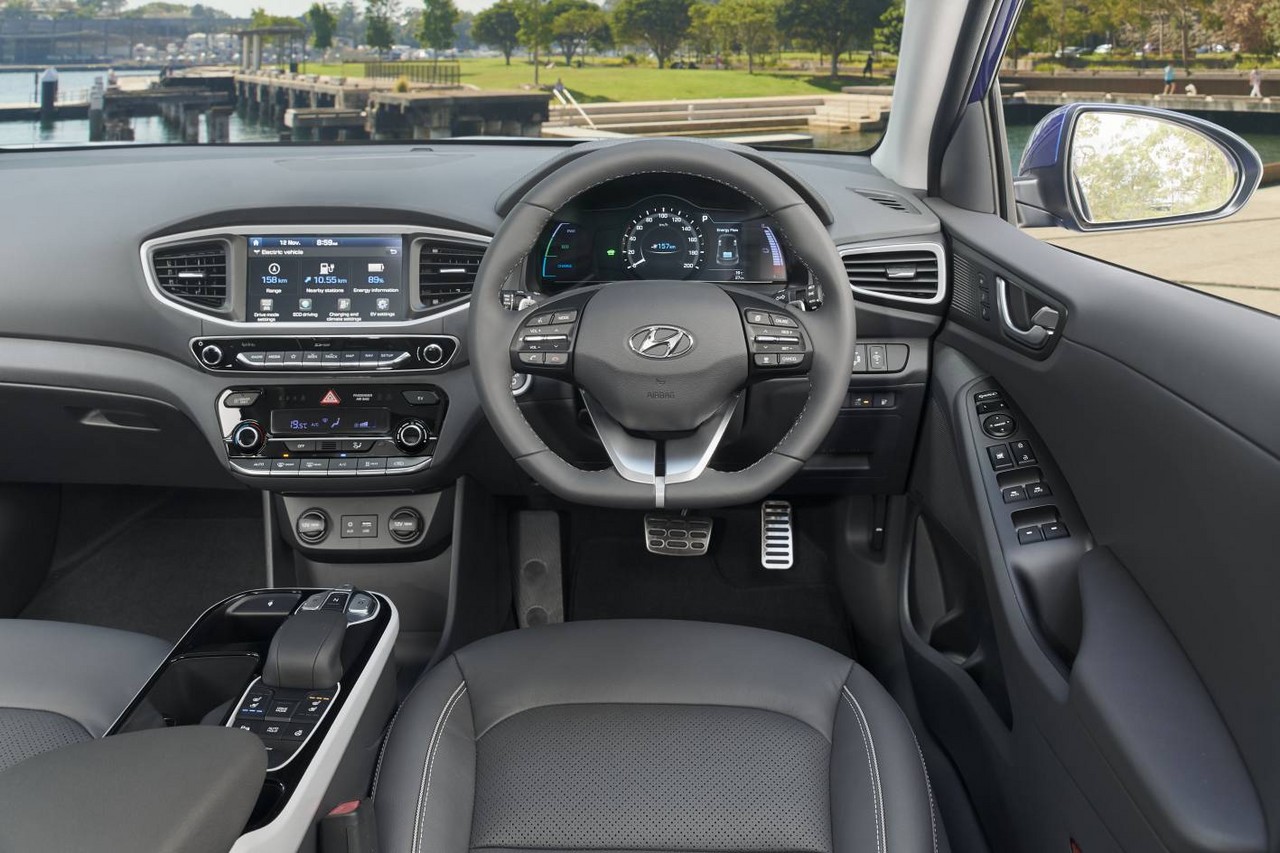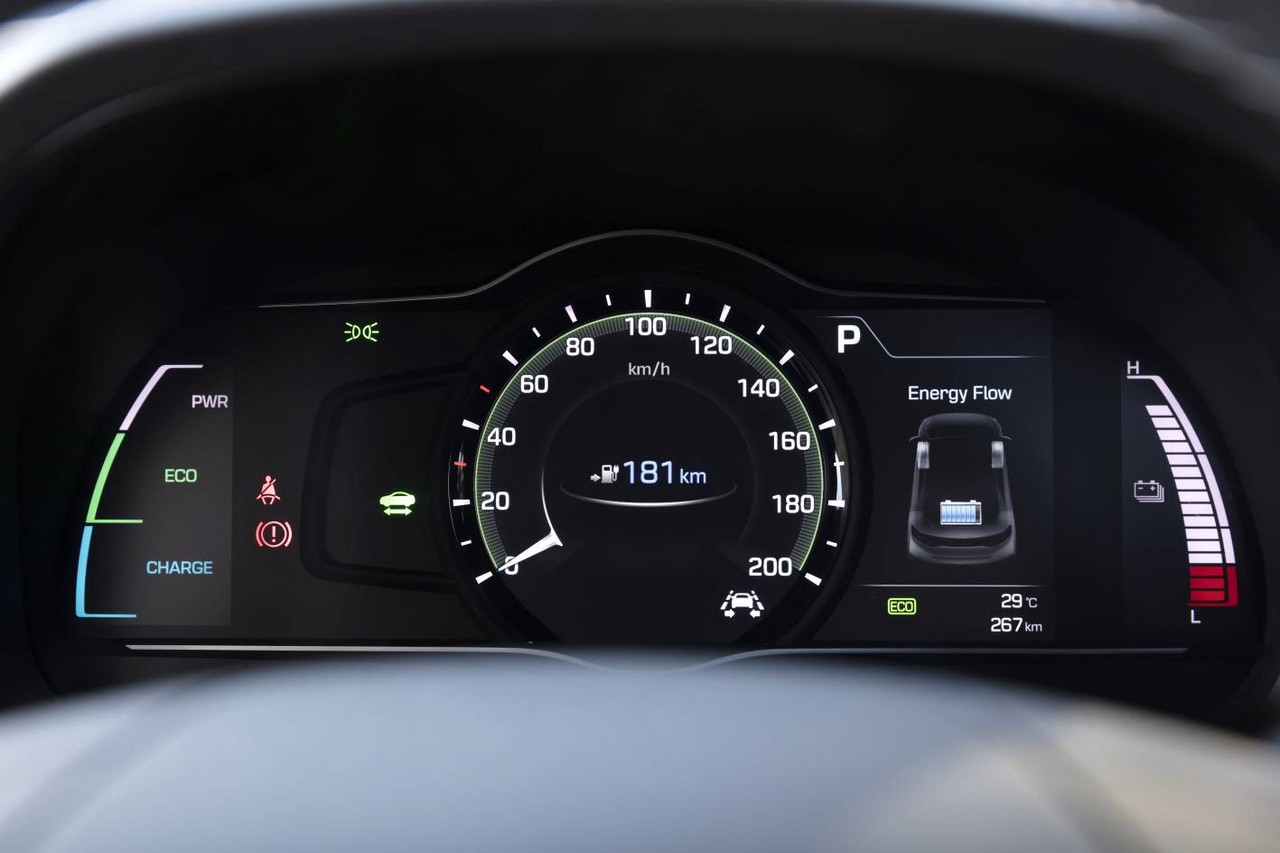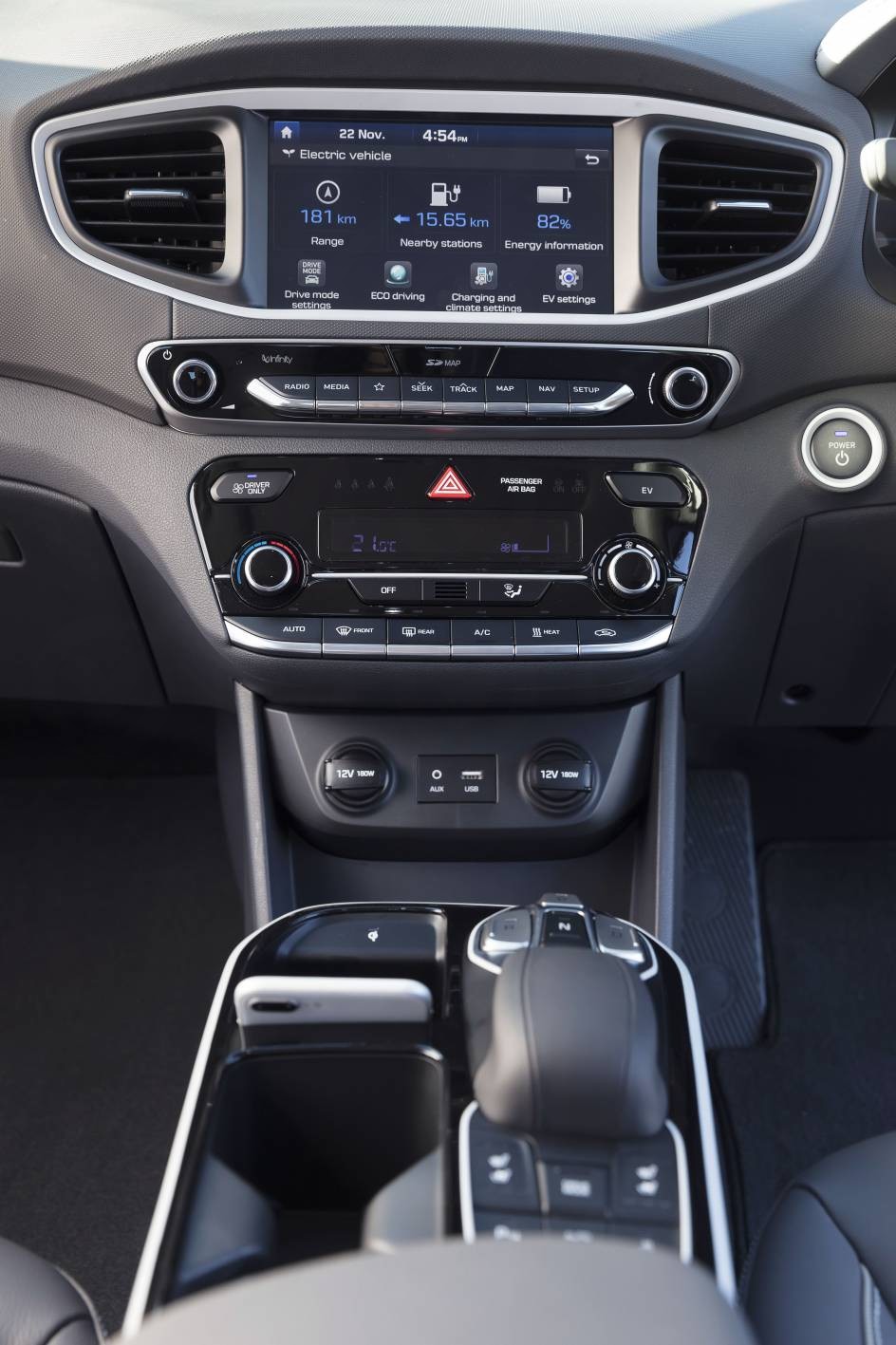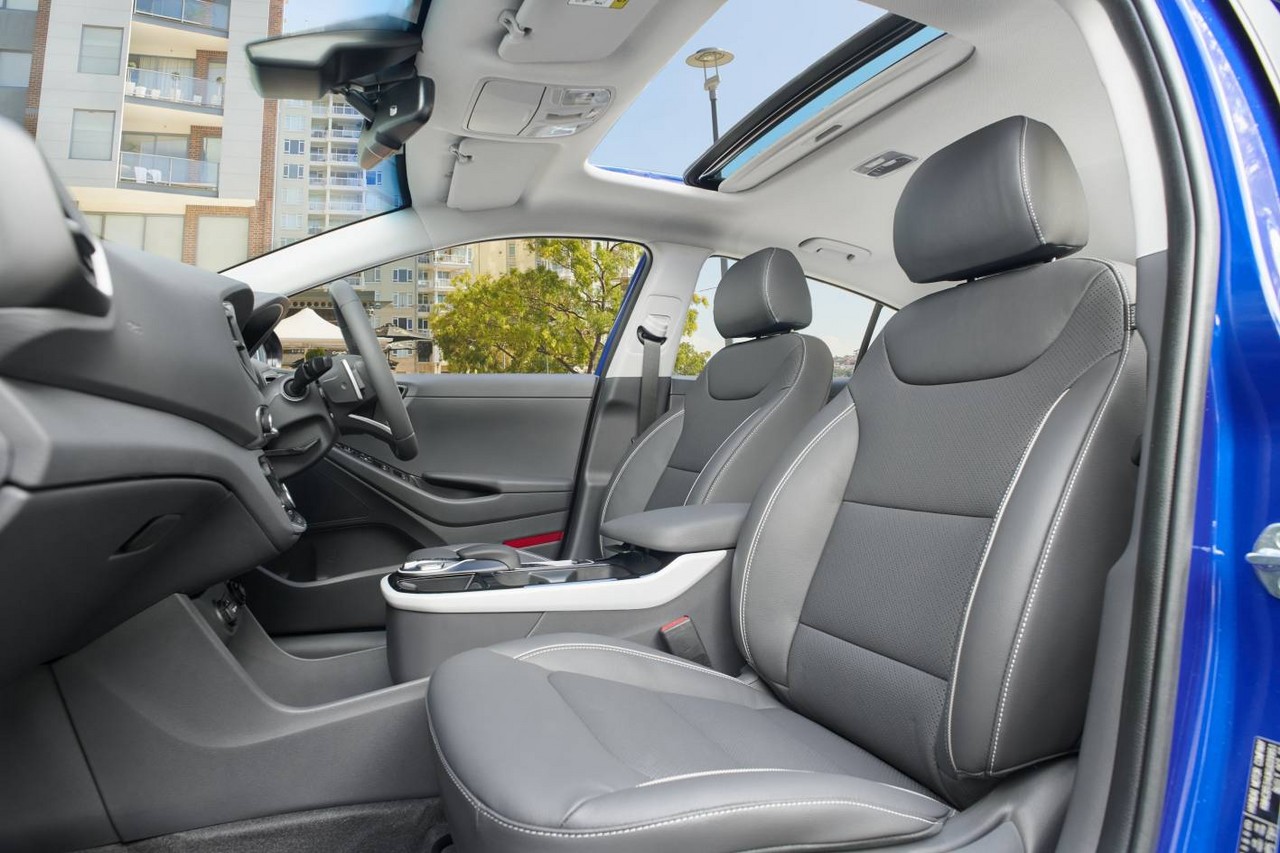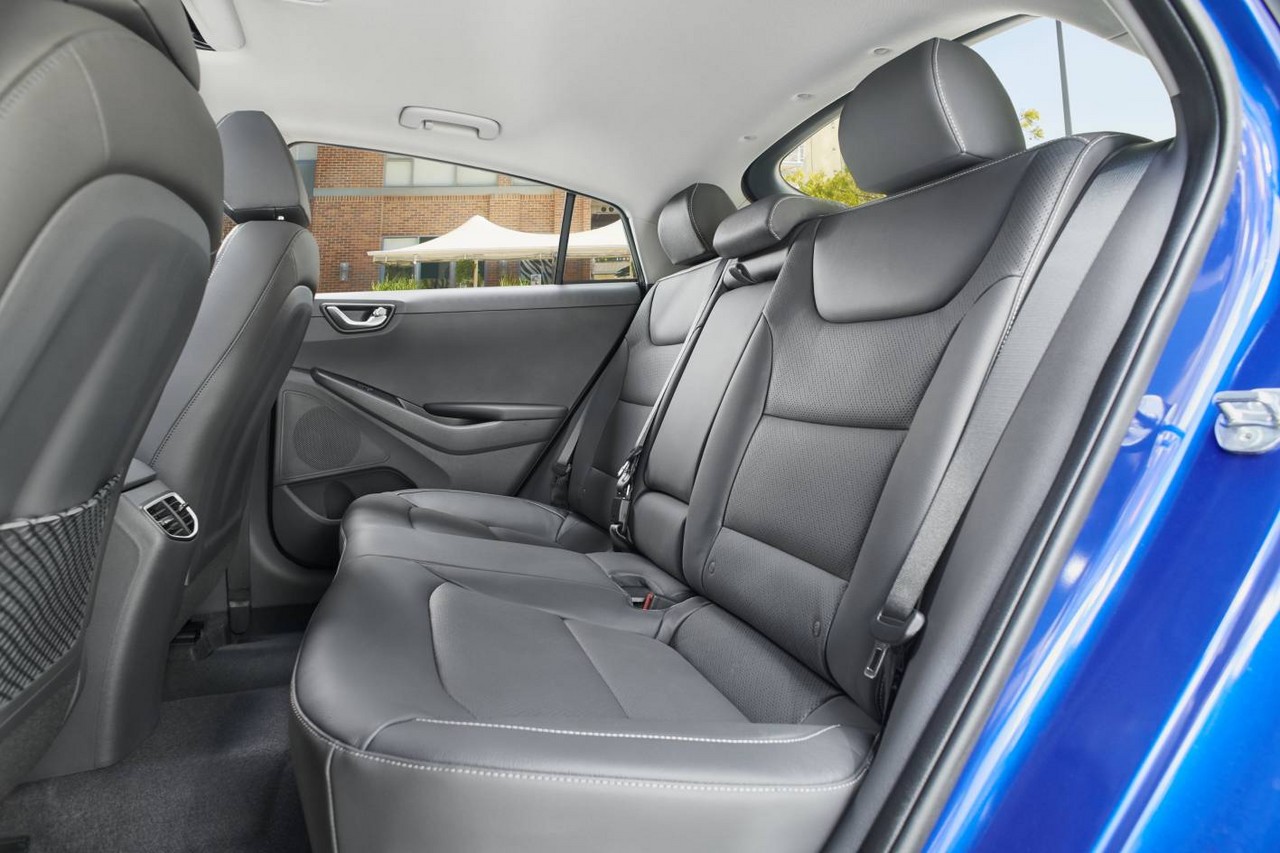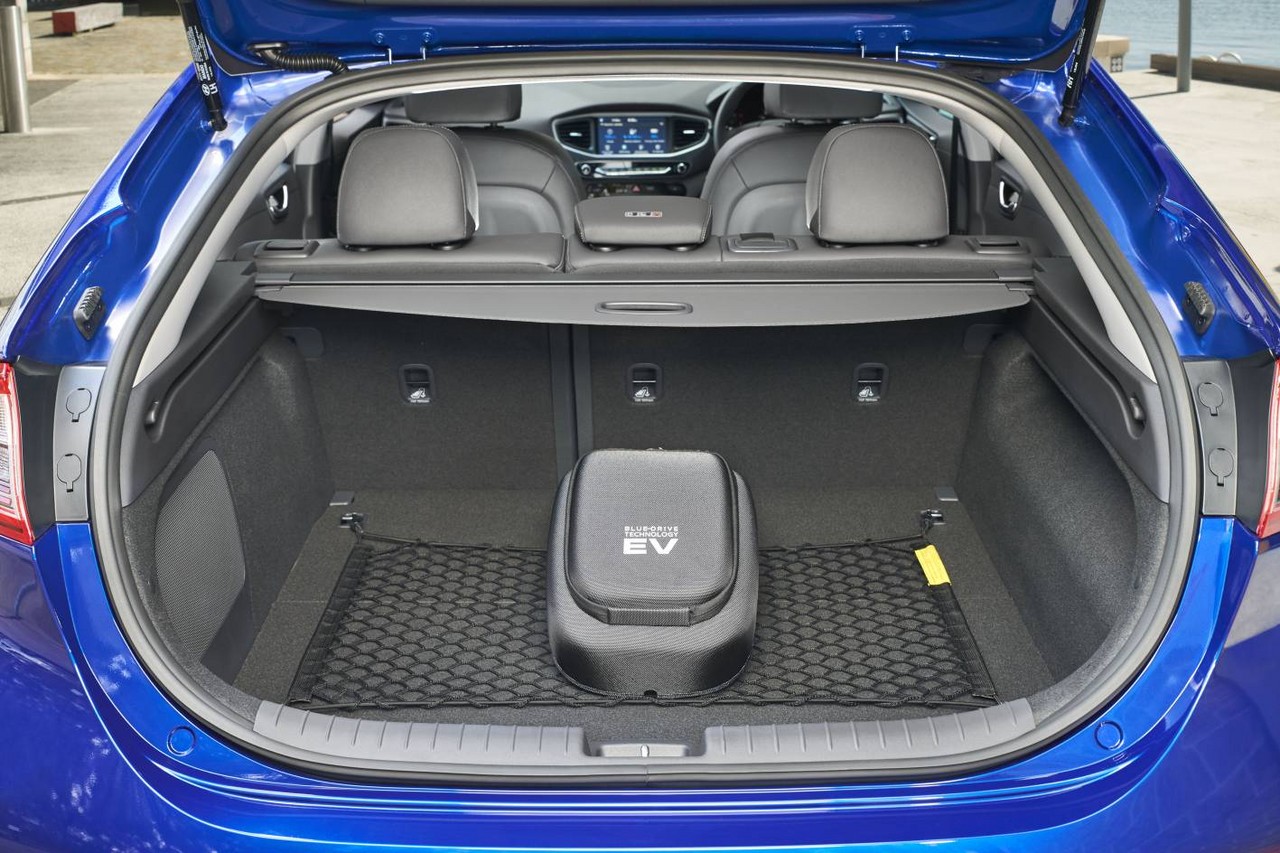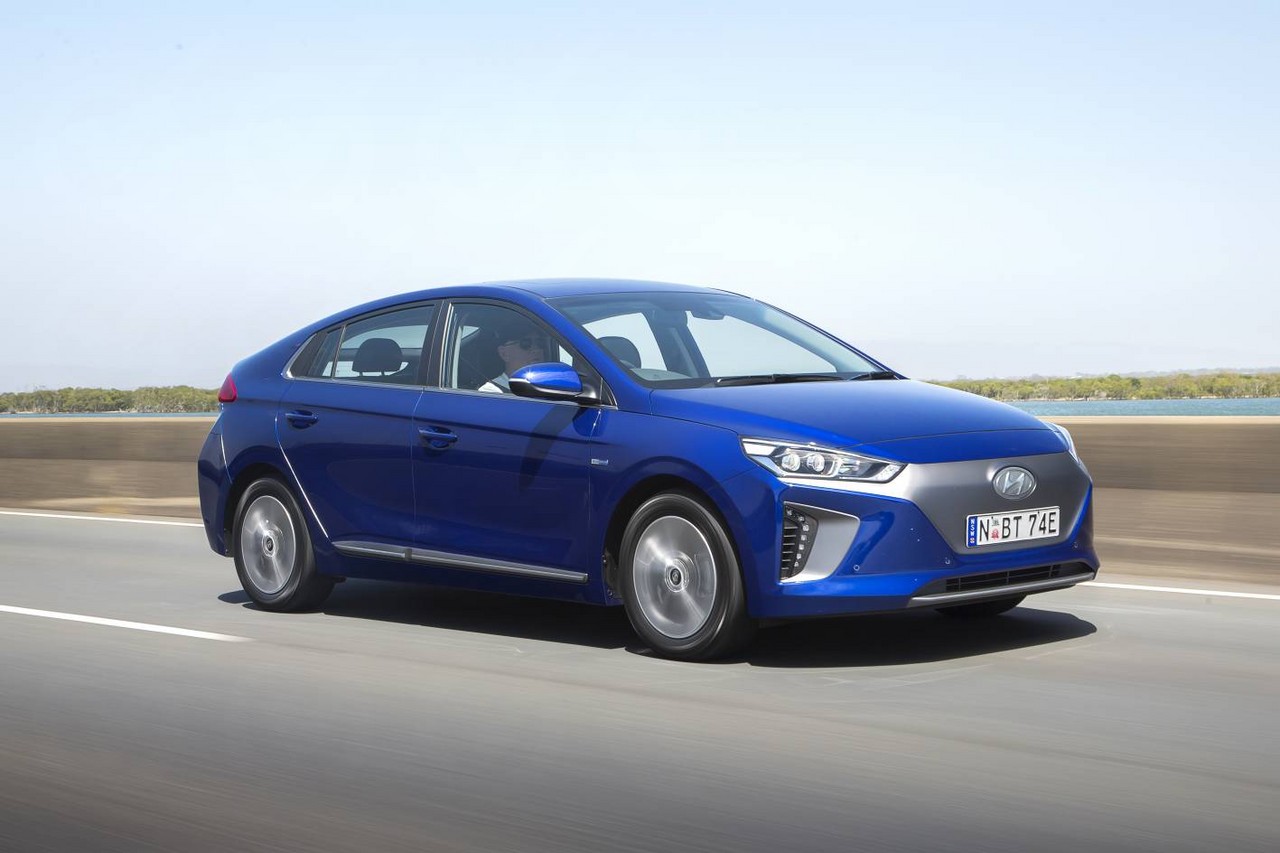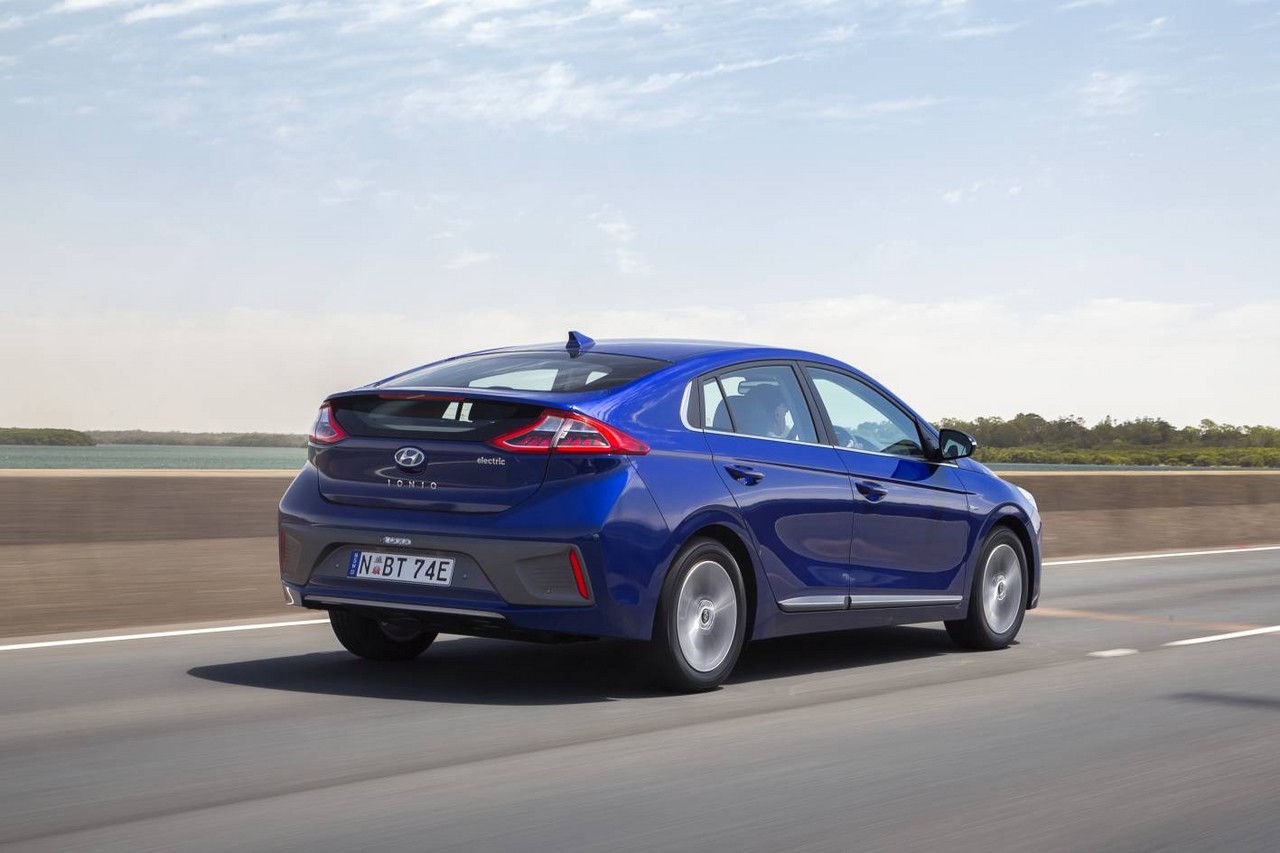
- The Hyundai Ioniq is a step in electric vehicles becoming affordable
- Familiar driving experience
- Competent ride/handling balance
- Five star safety rating and active safety technologies as standard
- Raked roofline makes for good aerodynamics…
- … but poor rear headroom, while rear spoiler splits the rear window
- Without the engine running, tyre roar and wind noise are noticeable
- Steering is vague and lacks feedback
- Foot-operated park brake for Hybrid and Plug-in Hybrid
- Shallow boot
- Dull interior surfaces
Overview
Released in Australia in November 2018, the Hyundai AE Ioniq was a front-wheel drive, five-door liftback that was available in three variants:
- Hybrid: powered by a 1.6-litre Atkinson cycle petrol engine and an electric motor that were mated to a six-speed double clutch transmission (DCT). The electric motor drew power from a 1.56 kWh lithium-ion battery which, generally, supplemented the petrol engine;
- Plug-in Hybrid: the same powertrain as the Ioniq Hybrid, but with a more powerful electric motor and a larger capacity lithium-ion battery (8.9 kWh). As such, the Ioniq Plug-in Hybrid had an electric-only range of 63 km and the petrol engine would supplement the electric motor provided the battery had sufficient charge; and,
- Electric: powered solely by a permanent magnet synchronous electric motor that drew power from a 28.0 kWh battery and was mated to a single-speed reduction gear. Furthermore, the Ioniq Electric had a real-world range of 230 km and its battery could be recharged to 80 per cent capacity in approximately 23 minutes using a 100 kW DC charger.
The Hyundai Ioniq was manufactured in Ulsan, South Korea, and its name was a portmanteau of ion and unique. Moreover, each Ioniq variant was available in Elite and Premium editions.
In Australia, the Hyundai Ioniq was sold with a five year unlimited kilometre warranty, while the high-voltage battery had an eight-year of 160,000 kilometre warranty.
2019 update
From the second half of 2019, the Hyundai Ioniq Electric will have a 38.3 kWh battery which provides a real-world range of 294 km (WLTP). The entire Hyundai Ioniq range will also be updated with –
- Hyundai Blue Link: provides remote locking/unlocking and control of the air conditioning via a smartphone app. For the Ioniq Electric, Hyundai Blue Link provides remote control of charging and start/stop functions
- A new 10.25-inch touchscreen and a new control panel for HVAC (heating, ventilation and air conditioning) controls; and,
- An updated front bumper design with a silver-coloured moulding at the bottom, black elements for the rear bumper moulding and daytime running light bezels, and new alloy wheel designs.
| Engine | Trans. | Peak power | Peak torque | |
|---|---|---|---|---|
| Ioniq Hybrid | 1580 cc petrol I4 | 6sp DCT | 77 kW at 5700 rpm | 147 Nm at 4000 rpm |
| Electric motor | 32 kW | 170 Nm | ||
| Combined | 104 kW | 265 Nm | ||
| Ioniq Plug-in Hybrid | 1580 cc petrol I4 | 6sp DCT | 77 kW at 5700 rpm | 147 Nm at 4000 rpm |
| Electric motor | 44.5 kW | 170 Nm | ||
| Combined | 104 kW | 265 Nm | ||
| Ioniq Electric | Permanent magney synchronous electric motor | 1sp reduction drive | 88 kW | 295 Nm |
Body and dimensions
Compared to the Hyundai PD i30 , the AE Ioniq was 130 mm longer (at 4470 mm), 25 mm wider (1820 mm), 5 mm lower (1450 mm) and had a 50 mm longer wheelbase (2700 mm). Furthermore, ground clearance was 142 mm and luggage capacity was 341 litres, though this increased to 1401 litres when the rear seats were folded down and luggage was filled to the roofline. The Hyundai Ioniq had a drag co-efficient of 0.24 Cd; to achieve this, aerodynamic measures included active front grille shutters, underbody panelling, front bumper air ducts which generated an ‘air curtain’ around the front wheels and an integrated tailgate spoiler.
According to Hyundai, the 53.5 per cent of the body of the AE Ioniq consisted of Advanced High-Strength steel (AHSS), including hot-stamped 150 kgf/mm2AHSS in the A- and B-pillars. To reduce mass, the Ioniq used aluminium for the bonnet, tailgate, front cross-beam, front lower arms, front knuckles, rear hub carriers and front brake callipers. As a result, unladen weights for the Hyundai Ioniq were as follows –
- Ioniq Hybrid: 1441 kg;
- Ioniq Plug-in Hybrid: 1475 kg; and,
- Ioniq Electric: 1527 kg.
Beyond this, noise reduction measures for the Hyundai Ioniq included an acoustic laminated windshield, foam-filled A- and B-pillars and ‘optimised’ floor panel sound isolation pads.
Suspension
The Hyundai Ioniq had MacPherson strut front suspension. The rear suspension, however, differed according to variant –
- The Ioniq Hybrid and Plug-in Hybrid had multi-link rear suspension; and,
- The Ioniq Electric had a torsion beam rear axle.
For Australian-delivered vehicles, the suspension for the Ioniq underwent a local tuning program.
Steering
The Hyundai Ioniq had rack-and-pinion steering with a column-mounted electric motor. The steering wheel required 2.66 turns from lock to lock and the vehicle had a turning circle of 10.6 metres.
Safety equipment
Standard safety equipment for the Hyundai AE Ioniq included dual front airbag, dual front knee airbags, front seat-mounted side airbags, full-length curtain airbags, ABS, electronic brakeforce distribution, brake assist, electronic stability control, traction control and front seatbelts with pre-tensioners and load limiters.
As standard, the Hyundai Ioniq was equipped with the following active safety technologies –
- Forward Collision-Avoidance Assist (FCA): operating at speeds above 10 km/h, FCA used the front radar sensor and windscreen-mounted camera to detect pedestrians (at speeds up to 70 km/h) and vehicles (at speeds up to 180 km/h). If a potential collision was assessed, a warning chime would sound and a warning would be displayed in the instrument cluster. If the driver did not respond, the brakes would be activated autonomously. At speeds below 80 km/h, the system would attempt to bring the vehicle to rest; above 80 km/h, the system would attempt to reduce vehicle speed;
- Lane Keeping Assist – Line (LKA-L): had three modes –
- Lane Departure Warning (LDW) mode: used the windscreen-mounted camera to detect lane markings and monitor the vehicle’s position in the lane. If the vehicle departed from its lane without the indicators having been activated, audible and visual warnings would be issued;
- Standard LKA mode: provided steering intervention as the vehicle was about to leave its lane; and,
- Active LKA mode: provided earlier steering intervention to assist the vehicle staying in the centre of its lane;
- Blind-Spot Collision Warning (BCW): operating at speeds above 30 km/h, BCW used radar sensors in the rear bumper to detect vehicles in the driver’s blind spot. If detected, a light in the door mirror would illuminate to alert the driver. If the driver then activated the corresponding indicator lights, the light would flash and a warning tone would sound;
- Rear Cross-Traffic Collision Warning (RCCW): used the rear radar sensors to monitor approaching traffic as the Ioniq reversed out of a perpendicular parking space. If RCCW detected a vehicle approaching, an audible warning would sound and a visual warning would be displayed in the instrument cluster;
- Smart Cruise Control (SCC): used the front radar sensor to detect the speed and distance of vehicles ahead of the Ioniq. SCC would then maintain a safe distance to that vehicle, up to the cruising speed – between 30 km/h and 180 km/h – set by the driver. If the vehicle ahead came to a stop, SCC would slow the vehicle to 10 km/h before prompting the driver to take control; and,
- Driver Attention Warning (DAW): operating at speeds above 60 km/h, DAW used the windscreen-mounted camera to monitor the vehicle’s position within its lane, in addition to monitoring steering inputs, brake pedal inputs and the time since the last break. If careless driving was detected, the ‘Attention Level’ display in the instrument cluster would decrease. If a minimum threshold was exceeded, the system would recommend that the driver take a break.
Beyond this, the Smart Cruise Control system for the Ioniq Electric had a ‘stop & go’ function. In stop/start traffic, the stop & go function could bring the vehicle to rest and, if stationary for less than three seconds, accelerate the Ioniq to its original cruising speed while maintaining a safe distance to the vehicle ahead.
Euro NCAP testing
In Euro NCAP testing , the Hyundai Ioniq received a five star safety rating which included a 91 per cent adult occupant protection rating and an 80 per cent child occupant protection rating. In the frontal offset test, protection of the front occupants’ heads and thighs were rated as good, but chest and lower leg protection was rated as adequate (i.e. a slight risk of serious injury). Maximum points, however, were awarded in the side impact and pole tests.
Wheels, tyres and brakes
Wheels and tyres for the Hyundai Ioniq were as follows –
- Hybrid: the Hybrid Elite had 15 x 6.0J alloy wheels with 195/65 R15 91H tyres, though the Hybrid Premium had 17 x 7.0J alloy wheels with 225/45 R17 91W tyres;
- Plug-in Hybrid: 16 x 6.5J alloy wheels with 205/55 R16 91H tyres; and,
- Electric: 16 x 6.5J alloy wheels with 205/55 R16 91H tyres.
While the Ioniq Plug-in Hybrid and Electric had a tyre mobility kit, the Ioniq Hybrid had a full-size alloy spare wheel.
The Hyundai Ioniq had 280 mm by 22 mm ventilated front brake discs and 262 mm by 10 mm solid rear discs.
Features: Hyundai Ioniq Elite
The standard infotainment package for the Hyundai Ioniq consisted of an Infinity audio system with eight speakers and an external amplifier, digital radio tuner (DAB+), an eight inch touchscreen, satellite navigation with SUNA live traffic updates, Bluetooth mobile phone connectivity and audio streaming, Apple CarPlay and Android Auto smartphone integration, and auxiliary 3.5 mm and USB inputs (with iPod compatibility).
Beyond this, standard features for the Hyundai Ioniq Elite included dual-zone climate control air conditioning, cruise control, projector beam headlights, LED daytime running lights, dusk-sensing headlights, a rear view camera with dynamic guide lines, 60:40 split folding rear seats, a leather appointed steering wheel and gear knob, remote central locking with proximity key, tilt and telescopic steering wheel adjustment, a height adjustable driver’s seat, power adjustable and heated door mirrors, push-button start, tyre pressure monitoring, two 12 volt power outlets (front centre console), illuminated vanity mirrors, a retractable cargo cover, a 4.2-inch instrument cluster LCD with digital speedometer and a trip computer, an alarm and immobiliser.
The Ioniq Premium was also equipped with ‘Hyundai Auto Link’ which used Bluetooth to connect the Ioniq’s on-board computer to a mobile phone so that owners could access vehicle information such as real-time diagnostics, tyre pressure monitoring, driving history statistics, parking management, service scheduling and access to roadside assistance.
Features: Hyundai Ioniq Premium
Compared to the Ioniq Elite, the Ioniq Premium was further equipped with leather appointed seats, ventilated and heated front seats, a ten-way power adjustable driver’s seat, a height adjustable front passenger seat, LED low beam headlights, rain-sensing wipers, front and rear parking sensors, a heated steering wheel, door mirrors with automatic folding and dipping on reverse, electrochromatic rear-view mirror, USB power outlet (front centre console), a wireless charging pad (Qi standard), a glass sunroof (tilt and slide operation), LED puddle lights and a 7.0-inch instrument cluster LCD. Furthermore, the Ioniq Hybrid Premium had bi-xenon headlights, whereas the Ioniq Plug-in Hybrid Premium had LED headlights.
The Ioniq Premium was also equipped with ‘Hyundai Auto Link Premium’ which provided remote operation of the door locks, remote engine start and climate control, geo-fencing alerts and could send emergency alert messages in the event of a collision.
Features: Hyundai Ioniq Electric
Features for Hyundai Ioniq Hybrid and Plug-in Hybrid Premium editions, the Hyundai Ioniq Electric Elite was further equipped with an electric parking brake, Hyundai Auto Link Premium, rain-sensing wipers, power folding door mirrors, a 7.0-inch instrument cluster LCD and puddle lights in the door mirrors, but had single-zone climate control air conditioning.
As such, the Hyundai Ioniq Electric Premium was distinguished by its heated and ventilated front seats, ten-way power adjustable driver’s seat with memory settings, LED headlights, front and rear parking sensors, heated steering wheel, height adjustable front passenger seat, door mirrors with automatic dipping on reverse, electrochromatic rear-view mirror, USB power outlet (front centre console), a wireless charging pad (Qi standard) and glass sunroof.
For a complete list of features and specifications, please refer to the ‘Specifications’ document, below.
Specifications
